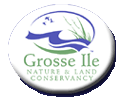

Vol. 12 No. 3
In this issue...
Reflections from the President
How the Nature Area Works with Other Groups
Garlic Mustard - Another Damaging Exotic
Nature Area Entrance - Native Garden
Did you know?
Upcoming Events...
November
6
Annual Meeting
10:00
AM
Centennial Farm
Members & Public
November
13
Work Day
9:00 AM
Nature Area

Did You Know ... ?
Items borrowed from Wildflowers of Michigan Field Guide by Stan Tekiela
Common Mullein (Verbascum thapsus)
Family: Snapdragon (Scrophulariaceae)
Height: 2-6’. Flowers: club-like spike, 1-2' long, of many small yellow flowers, packed along the stalk; each flower has 5 petals that open only a few at a time, from the top down.
Biennial: nonnative
Stan’s Notes: A European import, this plant is known for its very soft, flannel-like leaves, hence its other common name, Flannel Plant. This biennial takes two years to reach maturity. The first year it grows as a low rosette of large soft leaves; in the second, a tall flower stalk sprouts. It is said the Romans dipped its dried flower stalks in animal tallow to use as torches. Victorian women rubbed the leaves on their cheeks, slightly irritating their skin, to add a dash of blush. Early settlers and American Indians placed the soft woolly leaves in their footwear for warmth and comfort. Dried stems stand well into winter.
Spotted Knapweed (Centaurea maculosa)
Family: Aster (Asteraceae)
Height: 2-3’. Flower: each plant produces 25-100 lavender-to-purple flower heads, 1”wide, made entirely of disk flowers; each flower is underneath surrounded by a black-tipped, prickly brown bract.
Biennial: nonnative
Stan’s Notes: Spotted Knapweed is a nonnative plant commonly found growing in large groups along the side of the road and in open fields. It looks a lot like the garden annual, Bachelor Button. Its lavender flowers can range from white to red, but always have the triangular brown bracts. Its leaves often appear wilted and curled, and it is considered a noxious weed by many state agricultural departments due to its aggressiveness in crowding out other plants. Possibly an allelopathic plant that chemically changes soil to discourage other plants and favor its own offspring.